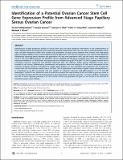| dc.contributor.author | Vathipadiekal, Vinod | |
| dc.contributor.author | Saxena, Deepa | |
| dc.contributor.author | Mok, Samuel C. | |
| dc.contributor.author | Hauschka, Peter Voorhees | |
| dc.contributor.author | Ozbun, Laurent | |
| dc.contributor.author | Birrer, Michael James | |
| dc.date.accessioned | 2012-05-10T18:17:43Z | |
| dc.date.issued | 2012 | |
| dc.identifier.citation | Vathipadiekal, Vinod, Deepa Saxena, Samuel C. Mok, Peter V. Hauschka, Laurent Ozbun, and Michael J. Birrer. 2012. Identification of a potential ovarian cancer stem cell gene expression profile from advanced stage papillary serous ovarian cancer. PLoS ONE 7(1): e29079. | en_US |
| dc.identifier.issn | 1932-6203 | en_US |
| dc.identifier.uri | http://nrs.harvard.edu/urn-3:HUL.InstRepos:8715718 | |
| dc.description.abstract | Identification of gene expression profiles of cancer stem cells may have significant implications in the understanding of tumor biology and for the design of novel treatments targeted toward these cells. Here we report a potential ovarian cancer stem cell gene expression profile from isolated side population of fresh ascites obtained from women with high-grade advanced stage papillary serous ovarian adenocarcinoma. Affymetrix U133 Plus 2.0 microarrays were used to interrogate the differentially expressed genes between side population (SP) and main population (MP), and the results were analyzed by paired T-test using BRB-ArrayTools. We identified 138 up-regulated and 302 down-regulated genes that were differentially expressed between all 10 SP/MP pairs. Microarray data was validated using qRT-PCR and 17/19 (89.5%) genes showed robust correlations between microarray and qRT-PCR expression data. The Pathway Studio analysis identified several genes involved in cell survival, differentiation, proliferation, and apoptosis which are unique to SP cells and a mechanism for the activation of Notch signaling is identified. To validate these findings, we have identified and isolated SP cells enriched for cancer stem cells from human ovarian cancer cell lines. The SP populations were having a higher colony forming efficiency in comparison to its MP counterpart and also capable of sustained expansion and differentiation in to SP and MP phenotypes. 50,000 SP cells produced tumor in nude mice whereas the same number of MP cells failed to give any tumor at 8 weeks after injection. The SP cells demonstrated a dose dependent sensitivity to specific γ-secretase inhibitors implicating the role of Notch signaling pathway in SP cell survival. Further the generated SP gene list was found to be enriched in recurrent ovarian cancer tumors. | en_US |
| dc.language.iso | en_US | en_US |
| dc.publisher | Public Library of Science | en_US |
| dc.relation.isversionof | doi:10.1371/journal.pone.0029079 | en_US |
| dc.relation.hasversion | http://www.ncbi.nlm.nih.gov/pmc/articles/PMC3260150/pdf/ | en_US |
| dash.license | LAA | |
| dc.title | Identification of a Potential Ovarian Cancer Stem Cell Gene Expression Profile from Advanced Stage Papillary Serous Ovarian Cancer | en_US |
| dc.type | Journal Article | en_US |
| dc.description.version | Version of Record | en_US |
| dc.relation.journal | PLoS ONE | en_US |
| dash.depositing.author | Vathipadiekal, Vinod | |
| dc.date.available | 2012-05-10T18:17:43Z | |
| dc.identifier.doi | 10.1371/journal.pone.0029079 | * |
| dash.contributor.affiliated | Hauschka, Peter | |
| dash.contributor.affiliated | Vathipadiekal, Vinod | |
| dash.contributor.affiliated | Birrer, Michael J. | |


